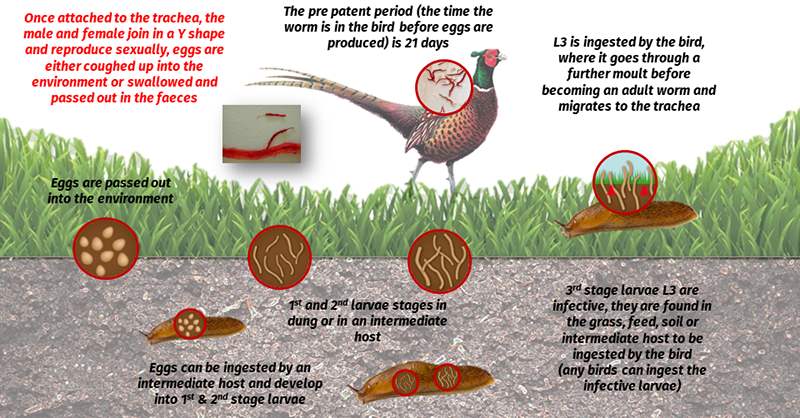Controlling the gapes, blackhead and hairworm in game birds
Veterinary surgeon Alistair Chilcott from Mount Vets discusses why in-feed medication with Flubenvet 5% is vital in supporting your birds’ health and performance.
“In a year where every poult is highly valued, we must ensure the birds’ health is looked after throughout the production cycle; especially in the release pen where challenges in the environment are less within our control,” says Alistair.
Which worms infect game birds?
“Worms (endoparasites) are a constant threat to the health of game birds out in wood, with three main species of concern: caecal worm (Heterakis gallinarum); hairworm (Capillaria); and finally, gapeworm (Syngamus trachea). Each of these species target different parts of the bird’s body, with their own individual life cycles,” he says.
The caecal worm targets the last part of the bird’s intestines, causing weight loss and poor thrift if present in high enough numbers. However, the biggest concern is its potential to carry another disease, blackhead, caused by a different parasite inside of the worm (Histomonas meleagridis). Blackhead can cause severe mortality, with very little effective treatment available. Our control method is therefore targeted at keeping worms under control in the first place.
The hairworm (composed of multiple individual species) can be found right through the early part of the bird’s intestines, and can cause weight loss, weakness, and high mortality.
Preventing ‘the gapes’ in game birds
Gapeworm is possibly the most common and well known of the worm species to affect gamebirds. Signs of infection include weight loss, the characteristic “gaping” as the bird struggles to breathe with a partially occluded windpipe, and often concurrent infection with other diseases (such as Hexamita and Coccidiosis) due to its immunosuppressive effect on the bird.
In addition to the adult worm, the immature life stages of the parasite also contribute to the disease as they cause damage whilst burrowing from the intestines, through the lungs towards the trachea (windpipe). The life cycle is rapid in this species, with the eggs taking between 7-14 days to develop into immature larvae; with another 7-14 days before new eggs are produced from the adults.

Alistair explains that worm eggs are very resistant in the environment and can survive for a very long time; gapeworm larvae can survive in earthworms for up to 3 years. Furthermore, wild bird species can introduce the disease to clean ground. Therefore, the risk is ever present.
“However,” adds Alistair, “regular treatment at intervals shorter than the life cycle of the worm can help to “clean-up” pens, as the larvae do not have the chance to develop to the adult stages and produce worm eggs themselves. Therefore, with a product that is effective against all life stages, birds can hoover up the infection, and break the cycle.”
How to treat worms in game birds
Treating disease in the release pen is especially difficult in comparison to the controlled environments of the breeding and rearing site. Poor weather conditions often bring on disease, but also bring the challenge of medicating birds effectively.
Alistair explains that it is often necessary to both worm and treat with antimicrobials or anticoccidials at the same time, putting pressure on the water system and the compatibility of multiple medications at the same time. He highlights that, with the temptation of puddles and streams, in-water medication is much less reliable at being effective. “To treat endoparasites effectively, birds need to consume the medication over a short period of consecutive days, usually around a weeklong. To achieve this, in-feed medication is a far more secure route,” he says.
In summary, Alistair describes the key characteristics for a worming product for birds in the release pen as being:
- Effective at killing all life stages of the parasites
- Licensed against all the major species of worms
- Be administered in the feed
Alistair concludes that Flubenvet™ 5% achieves all these demands of a worming medication which no other product can claim, and for these reasons is the industry’s leading product.
More Materials

Flubenvet™ 5% w/w premix for medicated feeding stuff.
A broad spectrum oral anthelmintic containing Flubendazole.

Flubenvet detail aid
Discover more about how worms affect the health and welfare of your birds.
Flubenvet 5% w/w Premix: for Medicated Feeding Stuff contains the active substance Flubendazole 50 mg/g. Flubendazole is a broad spectrum anthelmintic, effective against mature and immature stages and eggs of the following nematodes of chickens, turkeys, geese, partridges and pheasants: In the gastrointestinal tract: Ascaridia galli, Heterakis gallinarum, Capillaria spp., Amidostomum anseris and Trichostrongylus tenuis. In the respiratory tract: Syngamus trachea. Legal category: POM-VPS.
Information regarding the side effects, precautions, warnings and contra-indications can be found in product packaging and leaflet; further information can be found in the Summary of Product Characteristics.
Advice should be sought from the medicine prescriber prior to use. Prescription decisions are for the person issuing the prescription alone.
Flubenvet™, Elanco and the diagonal bar logo are trademarks of Elanco or its affiliates.